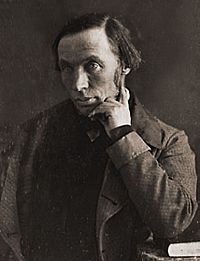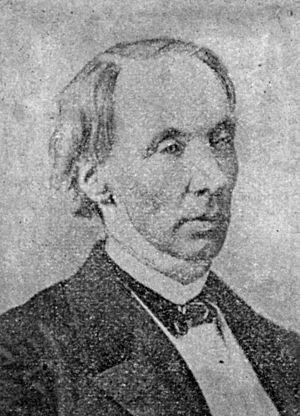Robert Dale Owen facts for kids
Quick facts for kids
Robert D. Owen
|
|
|---|---|

Robert Dale Owen as he appeared in the 1840s.
|
|
| U.S. Minister to the Two Sicilies | |
| In office 1853–1858 |
|
| President | Franklin Pierce |
| Preceded by | Edward Joy Morris |
| Succeeded by | Joseph Ripley Chandler |
| Member of the Indiana House of Representatives from the 76th district |
|
| In office 1851–1853 |
|
| In office 1835–1838 |
|
| Member of the U.S. House of Representatives from Indiana's 1st district |
|
| In office 4 March 1843 – 3 March 1847 |
|
| Preceded by | George H. Proffit |
| Succeeded by | Elisha Embree |
| Personal details | |
| Born | 7 November 1801 Glasgow, Scotland, UK |
| Died | 24 June 1877 (aged 75) Lake George, New York, U.S. |
| Nationality | British-American |
| Political party | Working Men's (1829–1831) Democratic (1832–1877) |
| Spouses |
Mary Jane Robinson
(m. 1832; died 1871)Lottie Walton Kellogg
(m. 1876) |
| Children | Florence Julian Dale Ernest Rosamond |
| Parents | Robert Owen and Ann (or Anne) Caroline Dale Owen |
| Signature | |
Robert Dale Owen (born November 7, 1801 – died June 24, 1877) was an important social reformer. He was born in Scotland but moved to the United States in 1825. He became an American citizen and was very active in politics in Indiana.
Owen was a member of the Democratic Party. He served in the Indiana House of Representatives and later in the U.S. House of Representatives. While in Congress, he helped create the famous Smithsonian Institution. He also served on its first board.
He was the son of Robert Owen, a well-known thinker about social equality. Robert Dale Owen helped manage New Harmony, Indiana, a special community his father started. Throughout his life, Owen wrote many books and articles about his ideas. He believed in things like women's rights, free public schools, and ending slavery.
Contents
Early Life and School Days
Robert Dale Owen was born on November 7, 1801, in Glasgow, Scotland. His mother was Ann Caroline Dale. His father was Robert Owen, a textile factory owner and a famous social reformer.
Robert Dale was the oldest of eight children. When he was sixteen, he went to a special school in Switzerland. This school taught him new ways of learning. After school, he worked with his father in the textile business in Scotland.
His father had big ideas about making society fairer. He wanted to create experimental communities where everyone was equal. Robert Dale Owen shared many of these ideas. In 1825, he moved to the United States to help his father manage the New Harmony community in Indiana. His brothers and sister also moved there.
Starting His Career
From 1825 to 1828, Robert Dale Owen was in charge of the New Harmony community. His father had gone back to Europe to continue his work there. Owen also worked with Frances Wright, a wealthy reformer from Scotland. They published articles in the New-Harmony Gazette, which was the town's newspaper. It was one of the first newspapers in Indiana.
After the New Harmony community ended in 1827, Owen traveled in Europe. He then returned to the U.S. in 1829. He moved to New York City and continued to work with Frances Wright. They edited a newspaper called the Free Enquirer. In this paper, they wrote about their strong beliefs. These included ending slavery, supporting women's rights, and having free public education for everyone. Owen returned to New Harmony, Indiana, in 1833.
Marriage and Family Life
Robert Dale Owen married Mary Jane Robinson on April 12, 1832, in New York City. After a trip to Europe, they moved to New Harmony, Indiana. They had six children together, but two of them died young. Their surviving children were Florence, Julian Dale, Ernest, and Rosamond.
Mary Jane Owen passed away in 1871. Five years later, on June 23, 1876, Owen married Lottie Walton Kellogg. He died just one year later.
A Life in Politics
Leading the Working Men's Party
From 1829 to 1830, Owen became an important leader in the Working Men's Party in New York City. Unlike some other politicians of his time, Owen was against slavery.
Serving in Indiana's Government
After returning to Indiana in 1833, Owen became active in state politics. He served in the Indiana House of Representatives from 1835 to 1838 and again from 1851 to 1853. He was a very influential member. During his first term, he helped get money for Indiana's public school system, which was supported by taxes.
Owen also tried to pass laws that would protect the property rights of married women and widows. He also wanted to make it easier for women to get a divorce. These ideas were quite new for his time.
In 1850, Owen was chosen to be a delegate for the Indiana Constitutional Convention. He suggested that the state constitution should include rights for women's property. Even though this idea wasn't approved then, his efforts helped lead to later laws that protected women's property, divorce, and voting rights. One of Owen's most important achievements was helping to add a section to the Indiana Constitution of 1851. This section made sure that there would be tax-funded, free public schools for everyone. It also created the job of the state's superintendent of public instruction.
Working in the U.S. Congress
After his first time in the Indiana legislature, Owen ran for the U.S. Congress twice and didn't win. But in 1842, he was elected as a Democrat to the U.S. House of Representatives. He served from 1843 to 1847. He was in charge of the Committee on Roads and Canals. He also took part in important discussions about adding Texas to the U.S. and settling the border with Canada in the Oregon area.
While in Congress, Owen introduced a bill that created the Smithsonian Institution in 1846. He helped make sure it passed. Owen was then chosen to be on the Smithsonian Institution's first Board of Regents. He led the committee that oversaw the building of the Smithsonian Institution Building in Washington, D.C.. He helped choose the architect and the materials for the building.
Owen, his brother David Dale Owen, and architect Robert Mills helped plan the Smithsonian Building. Their ideas influenced the final design, which used a Romanesque Revival style. Owen wrote a book called Hints on Public Architecture (1849). In it, he argued that this style was perfect for public buildings like the Smithsonian "Castle."
Serving as a U.S. Diplomat
Owen lost his election for Congress in 1846. However, he continued to work in public service. In 1853, President Franklin Pierce appointed him as the U.S. minister to the Kingdom of the Two Sicilies in Naples. Owen served in this important role until 1858. After that, he retired from political life, but he still cared deeply about public issues and social reform.
Other Important Political Work
During the American Civil War, Owen helped supply the Union Army. He was also appointed to a commission that studied the needs of formerly enslaved people. This commission later led to the creation of the Freedmen's Bureau.
In 1862, Owen wrote a series of open letters to important U.S. government officials, including President Abraham Lincoln. He urged them to support ending slavery for good. Owen believed that ending slavery would also help the Union army win the war. Just one day after Owen wrote a letter to Lincoln on September 17, 1862, Lincoln issued a first version of the Emancipation Proclamation. This important document declared many enslaved people free. Owen continued to write about how ending slavery would bring peace and suggested that the government should help freed people.
Later in his career, Owen kept working to get voting rights for women. In 1865, he wrote an early draft for a proposed Fourteenth Amendment that would not limit voting rights to men. However, the final version of the Amendment, which became part of the U.S. Constitution in 1868, only gave voting rights to men.
Belief in Spiritualism
Like his father, Robert Dale Owen became interested in Spiritualism. This is a belief system where people think they can communicate with spirits of the dead. Owen wrote two books about this topic: Footfalls on the Boundary of Another World (1859) and The Debatable Land Between this World and the Next (1872).
Later Years and Legacy
Even though he retired from public service in 1864, Owen continued to write. He wrote a novel called Beyond the Breakers (1870) and his autobiography, Threading My Way (1874). He also wrote articles for popular magazines.
In 1875, Owen became ill and was hospitalized for a few months. He recovered and went back to writing. In 1876, he married Lottie Walton Kellogg.
Death and Lasting Impact
Robert Dale Owen died on June 24, 1877, at his summer home in Lake George, New York. He was later buried in New Harmony, Indiana, next to his first wife.
One of Owen's most important contributions in Indiana was making sure that the state constitution provided money for free public schools. He also helped create the job of the state's superintendent of public instruction. His early work for women's rights was another key part of his legacy. Even though he didn't get all his ideas into the constitution, his efforts opened the way for future laws that gave women property, divorce, and voting rights in Indiana.
As a U.S. Congressman, Owen introduced the law that started the Smithsonian Institution in 1846. He also helped design the Smithsonian Institution Building in Washington, D.C.
Owen's efforts also helped with the issue of slavery. Through his open letters and writings during the Civil War, he strongly encouraged the end of slavery. He supported freeing all enslaved people and suggested that the government should help them. Historians believe his writings helped many people support the idea of emancipation.
Honors and Tributes
The town of Dale, Indiana, was named in honor of Robert Dale Owen.
In 1911, the women of Indiana dedicated a memorial to Owen. It was placed on the grounds of the Indiana Statehouse in Indianapolis. The memorial included a bronze statue of Owen. However, the statue disappeared in the early 1970s, and only its base remains today.
Selected Published Works
Owen wrote many pamphlets, speeches, books, and articles for newspapers.
- An Outline of the System of Education at New Lanark (1824)
- Popular Tracts (1830)
- Moral Physiology; or, A Brief and Plain Treatise on the Population Question (1830)
- Discussion on the Existence of God, and The Authenticity of the Bible (1833), co-written with Origen Bacheler
- Labor: Its History and its Prospects (1848)
- Hints on Public Architecture (1849)
- Footfalls on the Boundary of Another World (1859)
- The Policy of Emancipation: In Three Letters (1863)
- Emancipation is Peace (1863)
- The Wrong of Slavery, the Right of Emancipation, and the Future of the African Race (1864)
- Beyond the Breakers. A Story of the Present Day. Village Life in the West (1870)
- The Debatable Land Between this World and the Next (1871)
- Threading My Way: Twenty-Seven Years of Autobiography (1874)
- "Touching Visitants from a Higher Life," published in The Atlantic Monthly, volume 35, number 207, January 1875, pages 57–69.
See also
- Freedmen's town
- Josiah Warren


